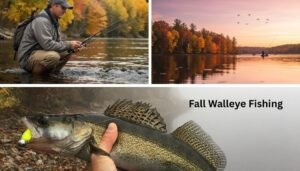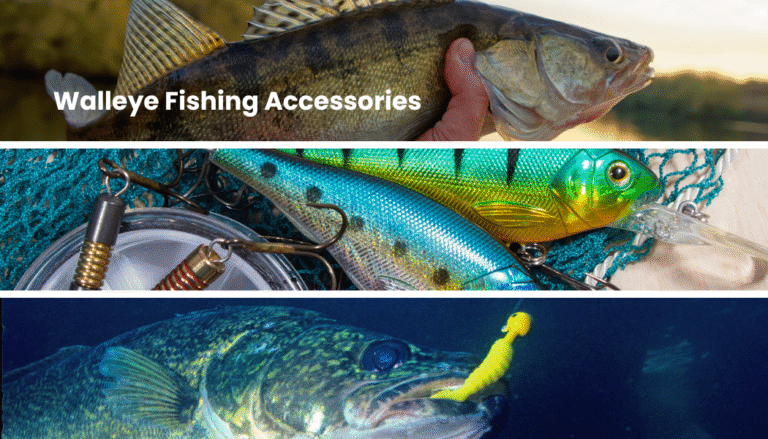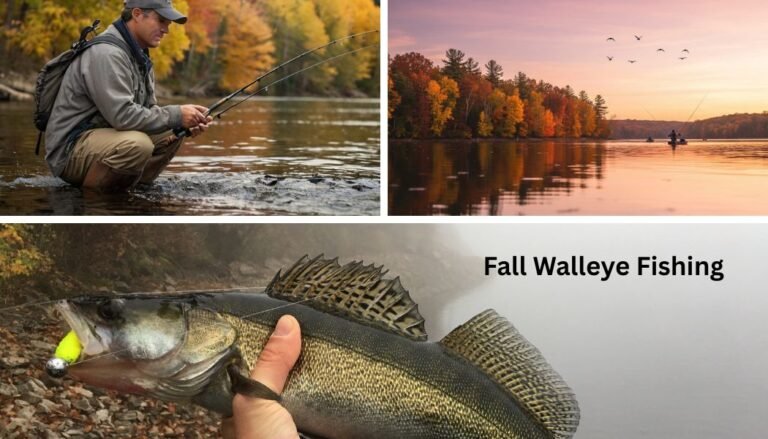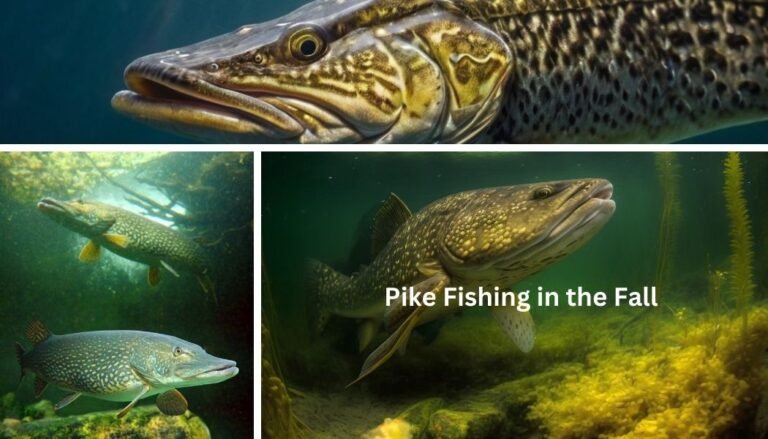Why Fall Is the Best Time to Target Trophy Walleye
Did you know fall is when walleye feed aggressively to prepare for winter, making it prime time for anglers to catch their personal best? I’ve fished through every season, but autumn has a magic all its own; cooler water temperatures, shifting feeding patterns, and the thrill of hooking into a heavy, gold-backed predator. In this guide, I’ll share the tactics, gear, and secret spots that make fall walleye fishing so rewarding. Whether you’re casting from shore, jigging deep structures, or trolling big water, these tips will help you land more fish and enjoy every crisp autumn morning on the water.
Understanding Fall Walleye Behavior
I’ll be real with you, figuring out fall walleye patterns has been a mix of obsession and frustration for me. Some years, I thought I had them pinned down, only to get skunked the very next trip. But once I started paying closer attention to the seasons, like really noticing water temps, daylight changes, and where baitfish were moving, it all started to click.

How shorter days and cooler water temperatures trigger feeding aggression
The first time I realized how much day length mattered, I was fishing late September at a reservoir. The bite was dead for hours, but right around sundown, when temps dropped a couple degrees, it was like a switch flipped. Walleyes that felt completely absent all afternoon suddenly lit up. That was my lightbulb moment; these fish feel the seasonal clock ticking. Shorter days tell them winter is coming, and cooler water (usually when it dips into the 50s °F) makes them crank up their feeding.
Pro Tip: Bring a thermometer. Don’t just guess. I’ve wasted too many trips ignoring temps when that number is a huge clue.
Walleye migration patterns in rivers, lakes, and reservoirs
Now, migration, that’s where I made some classic rookie mistakes. In lakes, I used to just keep hammering the same summer spots, only to find empty structure. What I didn’t know then was that walleyes shift toward shallow flats and rocky points in fall, especially near incoming streams where baitfish get funneled. In rivers, I’ve watched them stack up below dams and in deep runs, waiting for suckers and minnows to drift by. Reservoirs can be trickier, but creek arms and mid-lake humps have consistently held fish for me in October. A good sonar unit makes all the difference here. I finally started marking bait schools instead of blindly guessing.
The impact of baitfish movements on walleye location
I’ll admit, I used to ignore the “find the bait, find the fish” advice because it sounded too obvious. Huge mistake. One fall, I was dragging jigs along a breakline with zero luck. Then I noticed gulls dive-bombing about 200 yards away. I pulled up and sure enough, a school of minnows was getting pushed around. The walleyes were right under them. That day I learned: follow the birds, follow the bait. If you’re fishing a clear lake, polarized sunglasses help a ton for spotting surface disturbances.
Seasonal changes in strike windows and feeding depth
Something else I had to adjust to is how narrow their feeding windows get in the fall. In summer, you might get random bites throughout the day, but autumn walleyes are often on strict schedules. For me, dawn and dusk are golden. Midday can still work, but I usually have to go deeper, 20 to 30 feet isn’t uncommon. And here’s the kicker: sometimes they’ll crush a jig in shallow water at dusk, then slide right back into the basin by nightfall. If you’re not flexible, you’ll miss them completely. I started keeping a log of time, depth, and conditions. Flipping back through it has saved me a lot of trial and error.
So yeah, fall walleye fishing isn’t about luck; it’s about paying attention. Shorter days, colder water, baitfish movement, and those small feeding windows all connect. Once you line those up, it feels less like chasing ghosts and more like solving a puzzle.
Best Locations for Fall Walleye Fishing
Finding walleyes in the fall feels a lot like a treasure hunt. You can have the perfect bait and still blank out if you’re in the wrong place. I’ve burned more tankfuls of gas than I’d like to admit chasing fish around, but each mistake taught me something about where these critters like to set up once the leaves start changing.
Rivers with strong fall runs and prime current seams
One of my favorite fall memories is standing waist-deep in a chilly river, watching leaves drift by, and feeling that telltale “thunk” on a jig right in a current seam. Walleyes love those spots because the flow brings an endless buffet of bait right to them.
I used to cast randomly into the main current (rookie move), but now I zero in on the edges, where fast water meets slow. That’s the sweet spot. A jig tipped with a minnow or plastic gets swept just right in those seams, and walleyes can’t resist. Pro tip: if the water’s stained, don’t be afraid to upsize your presentation. A 4-inch paddle tail has saved me on days when smaller stuff vanished in the murk.
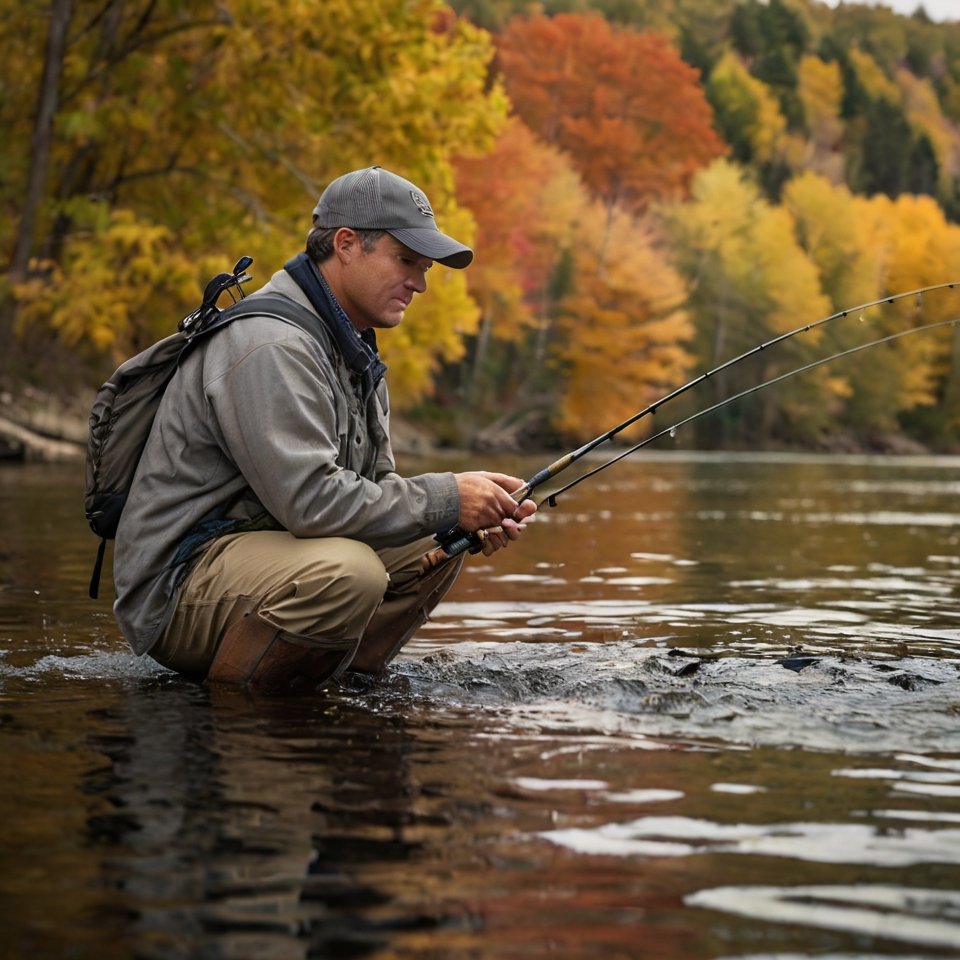
Lake points, drop-offs, and rocky structures
In lakes, fall walleyes act like nomads, and the structures are their highways. I’ll never forget fishing a windswept point in October, wind howling, hands freezing, and then boom, three fish in ten minutes. Wind-driven points push baitfish right into ambush zones, and walleyes set up shop. Drop-offs are another big one; if you can find a ledge that goes from, say, 10 to 20 feet quickly, that’s prime real estate. Rocky structures, especially riprap shorelines and mid-lake humps, are also killers in fall. Those rocks hold heat longer than sand or mud, and that little bit of warmth keeps baitfish, and in turn, walleyes, hanging around.
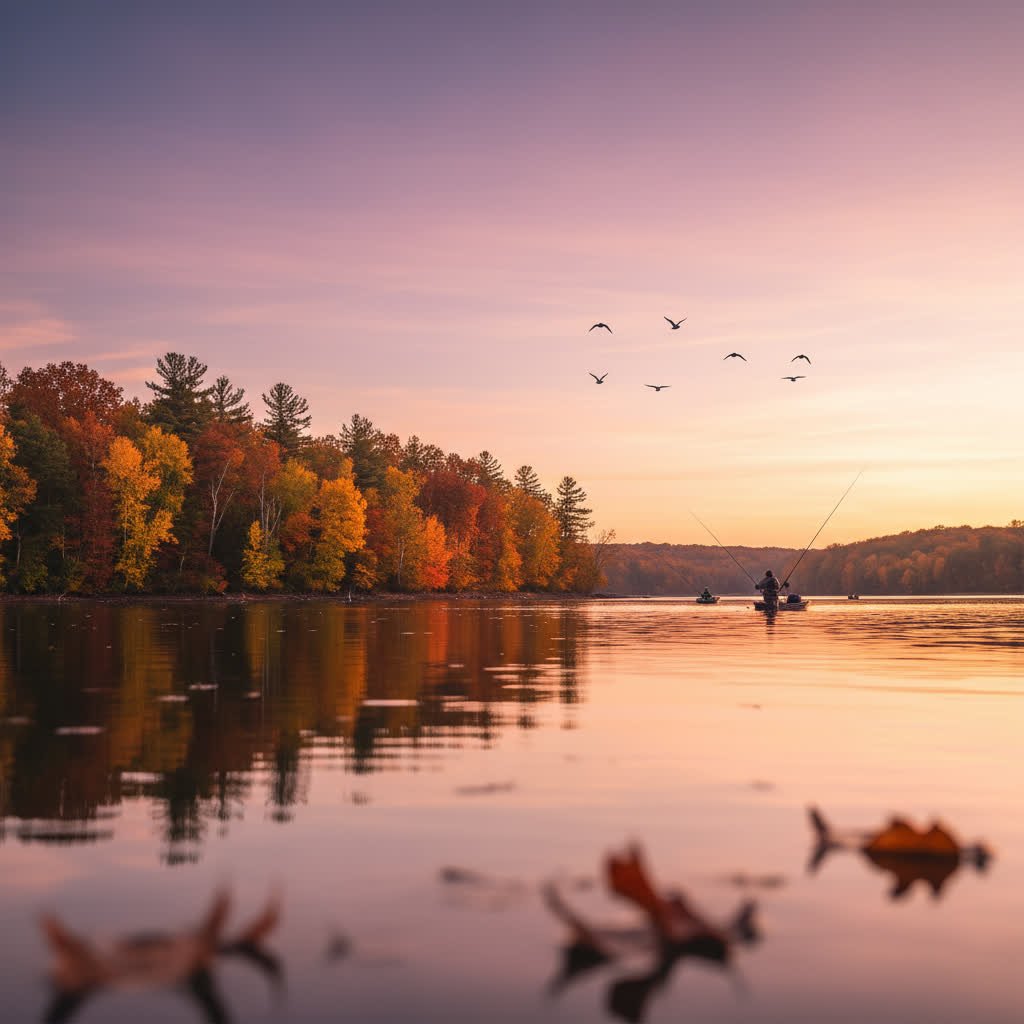
Reservoir channels and deep flats
Reservoirs used to confuse the heck out of me. Everything looks the same, and I couldn’t figure out why I’d mark fish one trip and nothing the next. Then I realized walleyes in reservoirs follow channels like a roadmap. Creek channels are gold in the fall, especially bends where deeper water meets shallower flats. Deep flats can also be sneaky-good. I’ve had days dragging bottom bouncers with live bait rigs across flats in 25 feet of water, picking up one solid walleye after another. A good mapping chip in your fish finder is worth its weight in gold here. I use mine like a GPS for fish.
Shore fishing hotspots for bank anglers
I’ll admit, I used to think bank fishing was a second-rate option compared to a boat. Big mistake. Some of my best fall nights have come sitting on a shoreline with a thermos of coffee, casting crankbaits into shallow water. Walleyes push bait right against the banks after dark, and you don’t need fancy gear to catch them. Bridges, riprap banks, and even boat ramps can be hot spots in October. One tip: bring a headlamp, but keep it off when you’re casting. I’ve spooked more fish than I’d like to admit by shining light straight into the water.
In the end, fall walleye fishing spots aren’t just “wherever”, they’re predictable if you know what to look for. Rivers? Hit the seams. Lakes? Find the points and rocks. Reservoirs? Follow the channels. And if you’re on foot, don’t underestimate the shoreline after sundown. Each location has its quirks, but once you dial them in, your odds go way up.
Proven Fall Walleye Fishing Techniques
Fall is the season that humbled me the most as an angler. I thought I had a solid bag of tricks, but walleyes in October and November forced me to rethink almost everything. What worked in July fell flat once the water cooled down. Over time, I’ve learned a handful of techniques that consistently put fish in the net during fall, but it took a lot of empty livewells (and some muttered curse words) to figure them out.
Jigging with live bait vs. artificial lures
The old debate, minnows or plastics. I’ll admit, I was a live bait purist for years. There’s something about a fathead minnow wiggling on a jig head that just feels right. And in cold water, that subtle movement can be deadly. But then one trip, I forgot my bait bucket (rookie mistake) and had nothing but a pack of 3-inch plastics in my tackle box. Guess what? The walleyes didn’t care. In fact, they hammered the plastics because I could work them faster and cover more water. My takeaway? Don’t get stuck on one or the other. If fish are finicky, a live minnow can seal the deal. If they’re aggressive, artificials let you experiment with colors, action, and speed.
Slow trolling crankbaits in colder water
Here’s where I ate some humble pie. I used to troll crankbaits the same way in fall as I did in summer, fast and wide. Big mistake. Colder water slows everything down, including the baitfish. Once I started dropping my trolling speed to 1.2–1.8 mph and letting the crankbait wobble more naturally, I started connecting. My go-to are stickbaits with tighter actions, like shad patterns. Bonus tip: long-lining behind the boat works wonders, but adding a planer board can help spread lines out and avoid spooking fish in clear water.
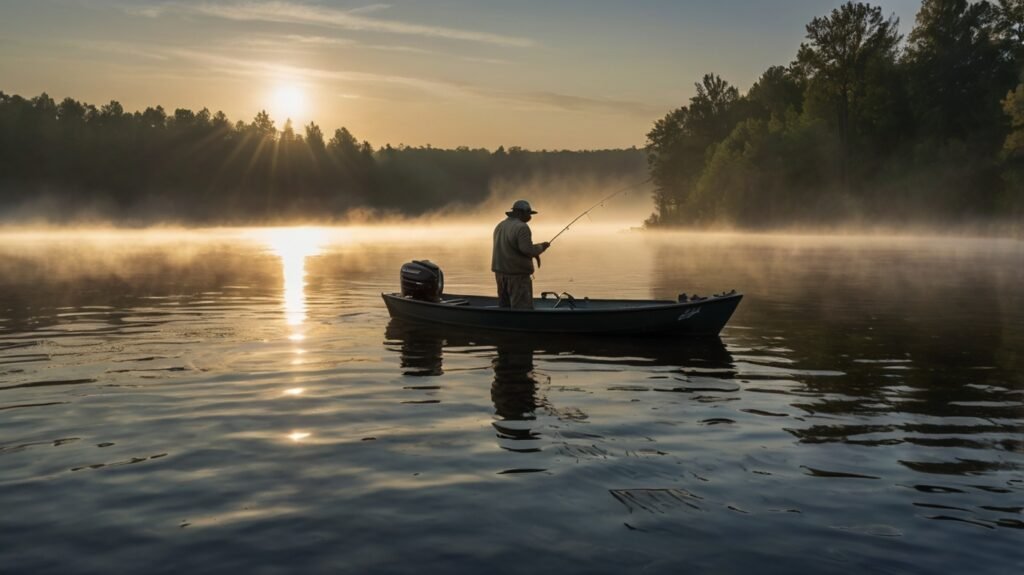
Vertical jigging for deep, late-fall fish
By late November, walleyes are practically glued to deep basins. My first attempts at jigging there were a disaster; I bounced my jig way too aggressively, and the fish scattered. What finally clicked was realizing they wanted finesse. A light lift, almost like you’re just letting the jig hover, works so much better than sharp snaps. Pair that with a sensitive rod, and you’ll feel those subtle “ticks” that are easy to miss. Blade baits and spoons also shine for this; drop them straight down and give them a tiny quiver.
Casting swimbaits and blade baits in shallow water
Not every fall walleye is deep. Some of my most exciting fishing has been chucking swimbaits into windblown shallows. I still remember one blustery October evening when I was about to pack it in. I tied on a 4-inch paddle tail, fired it toward a rocky shoreline, and bam, three walleyes in ten minutes. The key here is keeping the bait just above the rocks without snagging. Blade baits, on the other hand, are fantastic when fish are scattered. Cast long, let them sink, then use short lifts to make that metal flash. Walleyes crush them.
Night fishing advantages during autumn
I used to think night fishing was for burbot. Then one buddy dragged me out in late October, and my whole perspective changed. Walleyes move to shallow water under the cover of darkness, and you can have entire stretches of shoreline to yourself. Casting shallow-running crankbaits or even slip bobber rigs with live bait can light up the night. The hardest part? Staying warm. I’ve fished with numb fingers more than once, but a hot thermos and a couple layers make it bearable. Just don’t forget a headlamp (and extra batteries), I learned that lesson the hard way.
Fall techniques aren’t just about lures or speed; they’re about adapting to the fish’s mood. Some nights, they want a minnow barely wiggling on the bottom. Other days, a vibrating blade bait ripping through shallows does the trick. The more I let the season dictate my presentation instead of my stubborn habits, the more success I’ve had.
Essential Gear for Fall Walleye
I used to think fall fishing was all about being at the right spot at the right time. And while that’s a big part of it, I learned the hard way that having the wrong gear can make even a “perfect” setup miserable. One October, I snapped a cheap rod jigging in 30 feet of water and ended up spooling my reel into a bird’s nest in the dark. Not exactly the memory you want when the fish are finally biting. Over time, I’ve dialed in my fall arsenal, and having the right tools has made the difference between frustration and a cooler full of fillets.
Rod and reel setups for jigging, trolling, and casting
Let’s start with rods. For jigging, I swear by a 6’6″ to 7′ medium-light rod with fast action. That sensitivity helps detect those soft “ticks” when a walleye grabs your jig and just sits with it. For trolling, longer rods (7’6″ to 8’6″) spread lines out better and keep crankbaits running true. Pair those with a line-counter reel, and you’ll hit the same depth every time, huge for consistency. For casting swimbaits and blade baits, a medium-power 7-foot rod feels like the sweet spot. It’s strong enough to launch heavier lures but still gives you that crisp hookset when a fish smacks mid-retrieve.
Line selection: braid vs. fluorocarbon vs. monofilament
I’ll be honest, I messed this up for years. I once ran straight braid trolling crankbaits, and every fish came unpinned. Why? No stretch. Walleyes shook the hooks loose. These days, I run braid (10–15 lb) for jigging because the sensitivity is unbeatable; you feel everything. For casting, I’ll sometimes use braid with a fluorocarbon leader to stay stealthy in clear water. But when I’m trolling, mono is still king. That little bit of stretch acts like a shock absorber and keeps hooks buried. Fluorocarbon leaders are also clutch when walleyes are line-shy, especially in gin-clear lakes.
Top-performing lures and bait rigs for the season
Fall is when I slim down my tackle box, but make every option count. A handful of jig heads in 1/8 to 3/8 oz, paired with minnows or plastics, will cover most situations. For trolling, stickbaits like Rapala Husky Jerks and Shad Raps are staples. Swimbaits in the 3–5 inch range are killers on windy points, and blade baits like the Johnson Thinfisher or Heddon Sonar shine when fish are deeper. Don’t overlook live bait rigs either, slip sinkers with a minnow on a long snell are old-school, but they flat-out work in cold water.
Cold-weather fishing apparel and safety gear
This is the part I underestimated for way too long. I’ve toughed it out with frozen fingers and jeans soaked from boat spray, it wasn’t fun. Now, I gear up like I’m heading into a snowstorm. A good pair of insulated bibs and a waterproof jacket make the difference between staying out until the evening bite or heading home early. Layering is key: thermal base layers, fleece mid-layers, and waterproof outer shells. And don’t forget hands and feet, insulated boots, and windproof gloves are lifesavers. On the safety side, a life jacket is non-negotiable, especially in frigid water where hypothermia can set in fast. I also carry a small dry bag with extra clothes, just in case.
Fall walleye gear isn’t about having the most expensive setup; it’s about reliability and comfort. The right rod, the right line, a few proven baits, and clothing that keeps you warm and safe can turn a tough, cold day into one of those trips you’ll talk about all winter.
Reading the Water and Weather
For years, I thought catching fall walleyes was just about being stubborn; stay out long enough and eventually you’d stumble into fish. But over time, I realized the guys consistently putting big ones in the boat weren’t just “lucky.” They were reading the water and weather like a playbook. Once I started paying closer attention to wind, water clarity, temperature swings, and what my electronics were telling me, my catch rate went way up. I still mess it up sometimes, but I’m a whole lot better than the guy blindly casting into dead water.
How wind direction affects walleye positioning
If there’s one lesson I learned the hard way, it’s this: don’t hide from the wind. One fall trip, I tucked into a calm bay because it was easier to fish, only to blank while a buddy hammered walleyes on a windblown point. Walleyes follow the food, and wind pushes baitfish against shorelines, points, and rocky structures. A strong north wind in October will pile minnows up on the south-facing banks, and sure enough, the walleyes are right behind them. I now purposely chase wind-driven areas, even if it means getting pelted with spray. Casting swimbaits or crankbaits into those waves can be brutal on your arms, but it’s worth it.
Water clarity and its influence on lure choice
Water clarity is another thing I used to ignore, and it cost me. In clear lakes, I once ran bright chartreuse crankbaits and couldn’t buy a bite. Switched to natural shad patterns with a little flash and instantly hooked up. On the flip side, stained water demands more visibility; bright colors, rattles, or lures with vibration help walleyes zero in. One little trick I use is running a fluorocarbon leader in gin-clear conditions; it makes presentations way more subtle. But in muddy rivers, I’ll ditch the finesse and go loud and flashy, paddle tails with chartreuse or even fire tiger crankbaits.
Adjusting to sudden temperature drops
Ah, the dreaded cold front. I remember a November weekend where the temperature plummeted overnight. My buddy and I fished all morning with zero action. I finally realized the walleyes had slid deeper and were sulking. Instead of pitching jigs shallow, we switched to vertical jigging in 25 feet with small minnows, and suddenly started picking up fish. Temperature drops usually slow them down, so subtle presentations become key. Slow trolling, lighter jigging strokes, and live bait often outfish aggressive tactics when the weather turns nasty.
Using electronics to locate fish in fall conditions
For the longest time, I thought sonar was just for finding depth. I’d see blips on the screen and not know what I was looking at. Once I started learning to read my electronics, everything changed. In fall, baitfish balls look like big clouds on the graph, and if you see arcs hanging below them, that’s your walleyes. Side imaging has been a game-changer, too. I can scan rocky points and see fish sitting right on the edges without even dropping a line. My advice: spend as much time learning your electronics as you do casting. I used to waste hours fishing “fishy-looking” spots, but now I know within minutes whether a spot is holding life or just empty water.
Reading water and weather isn’t glamorous; it’s not as much fun as talking about your favorite lure color. But it’s the difference between going home empty or going home with stories (and fillets). The more time I spend paying attention to those subtle cues, the more consistent I get. And honestly, that feels even better than luck.
Common Mistakes to Avoid
If there’s one thing fall walleye fishing has taught me, it’s that stubbornness doesn’t put fish in the net. I used to think I could just fish the same way I did in summer, same lures, same speed, same shallow spots, and the walleyes would play along. Spoiler: they didn’t. What finally turned things around was recognizing the dumb mistakes I kept repeating and adjusting before the whole day went south.
Fishing too fast in cooling water
This was mistake number one for me. In early fall, I’d be ripping crankbaits at 2.5 mph like it was still August. Then the water would hit the low 50s, and suddenly walleyes wanted no part of that. I remember trolling for hours one chilly October morning without a sniff. Finally, I slowed down to just over 1 mph, and boom, the rod doubled over with a fat 24-incher. Lesson learned: as the water cools, your whole presentation needs to slow down. Jigging strokes get softer, trolling speeds drop, and patience becomes the name of the game.
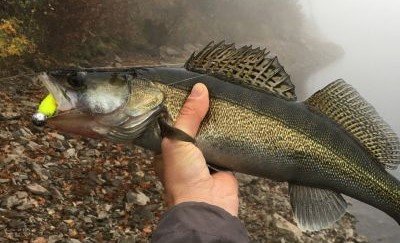
Ignoring depth changes and structure transitions
For way too long, I wasted time casting at random shorelines because they “looked good.” Walleyes don’t care how pretty a spot looks; they care about depth and structure. One trip on a clear lake, I pounded a shallow weed edge for hours with nothing. When I finally checked my graph, the baitfish were stacked at 18–20 feet just off a drop-off. The walleyes were right below them. Now I make it a rule: always check depth transitions and mid-lake humps before committing. Walleyes move up and down with light and temperature changes, and if you’re not adjusting, you’re fishing empty water.
Using summer lure colors in fall conditions
This one stings because I’m stubborn about my favorite lures. I used to throw perch-pattern crankbaits year-round because they looked good to me. In the fall, though, shad, smelt, and other silvery baitfish dominate their diet. I learned this the hard way during a tournament. I caught one tiny fish all morning while another guy crushed it with natural silver and blue cranks. Since then, I stock up on shad patterns, chrome finishes, and even firetiger for stained water. The takeaway? Match what they’re actually eating right now, not what worked two months ago. Our download section has a walleye bait color chart.
Overlooking nighttime bite opportunities
I’ll admit, I used to pack it in when the sun went down. Then one October, a buddy dragged me out for a night trip, and I was blown away. Walleyes that seemed nonexistent during daylight were crushing shallow crankbaits after dark. I caught my personal best that night, standing under a bridge with nothing but a headlamp and a thermos of coffee. Since then, I have never written off the night bite. Fall walleyes feel safer pushing shallow under the cover of darkness, and shore anglers especially can cash in big here. If you’re skipping nighttime fishing, you’re leaving a pile of opportunities on the table.
At the end of the day, avoiding these mistakes isn’t about being perfect; it’s about paying attention. Slow down, fish the right depths, match the seasonal forage, and don’t sleep on the night bite. Fall walleyes reward the patient and the adaptable. Trust me, I’ve learned that lesson with plenty of empty coolers to prove it.
Hooking Your Fall Trophy
Fall walleye fishing offers a unique mix of challenge and reward. By understanding seasonal patterns, targeting the right structures, and adjusting techniques to cooling water, you set yourself up for some of the best fishing of the year. Don’t just wait for summer bites, grab your gear, watch the weather, and head out while the leaves are turning. Your next trophy walleye could be waiting in the chill of an autumn morning.
FAQ Section
What is the best month for fall walleye fishing?
The best months for fall walleye fishing are typically September through November, depending on your location. Early fall offers active shallow bites, while late fall often means targeting deeper fish as water temperatures drop.
What lures work best for fall walleye?
In the fall, walleye respond well to jigs with minnows, crankbaits, blade baits, and swimbaits. Match lure color to water clarity: bright or metallic in stained water, and natural colors in clear water.
Can you catch walleye from shore in the fall?
Fall is one of the best times for shore fishing walleye, especially during evening and nighttime hours when they move shallow to feed on baitfish near rocks, piers, and drop-offs.
How deep are walleye in the fall?
Depth varies with the season stage. In early fall, walleye may be found in 5–15 feet of water. As temperatures drop in late fall, they often move deeper, 20–40 feet, near structure or along channel edges.
Is night fishing effective for fall walleye?
Many anglers prefer night fishing in the fall because walleye feed heavily after dark. Casting crankbaits or slow-rolling jigs in shallow areas can produce trophy-sized fish.
Disclaimer: This blog post contains affiliate links

